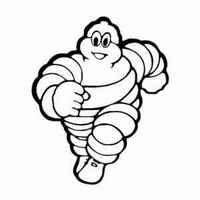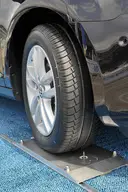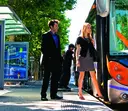Your (Tire) Future According To Michelin
 Your (Tire) Future According To Michelin |
By Henny Hemmes
Senior European Editor
The Auto Channel
AMSTERDAM, August 10, 2011; Public transport with in- and egress, never again a flat tire, more efficient truck haulage… That’s what the future has in store for us, thanks to innovative tire technology developed by Michelin. The French manufacturer presented its innovations during the 11th Michelin Challenge Bibendum, an international five day event with conferences, workshops and demonstrations concerning solutions for sustainable mobility.
In 1998, Michelin and its partners organized the Challenge for the first time. In the meantime, the event can be considered as a major worldwide platform for companies to promote products, visions and development for mobility of the future.
 |
Except for the prototypes of the Audi Q5 hydrogen, electric A4 and Porsche Boxster electric, 270 sustainable models could be tested on one of the routes that were set up on the airfield, covering a total length of 10 miles
When Michelin organized its first Challenge, hardly anybody talked about CO2-emissions and electric drivelines. Nowadays, fuel efficiency and decreasing emissions are hot issues and Michelin is convinced that the ‘Bibendum’ event is influencing public awareness of technologies that improve fuel efficiency. Such as the eco tires, of which Michelin sells 30 million units a year.
 |
In the meantime Michelin is addressing some of the issues that are within the competence of the tire manufacture. In Berlin, the French showed the steps its research and development division is making toward future mobility, without the sacrifice of performance and quality. Its innovations should generate better safety, weight- and fuel-savings and, consequently, lower emissions.
 |
One of the innovations is a tire that will not loose even the slightest amount of air. At the Bibendum Challenge, Michelin showed a prototype, mounted on a car that drove back and forth over ‘bed’ with 32 spikes. Such a tire offers better security as well as peace of mind for the driver. Because there is no need for a spare wheel anymore, nor for a crick and wheel wrench SLEUTEL, some 66 lbs can be saved, which will decrease CO2-emission by 1.9 g/km. For the ‘self-repairing’ tire, Michelin has filed 15 patents.
The revolutionary tire is expected to hit the market in 3 to 5 years time and it will mark the end of the run-flat tires, that common now and can be used for about 50 miles with a puncture.
 |
Active Wheels
In 2008, the tire manufacturer introduced the Active Wheel for electric and
hybrid vehicles. It combines an electric engine, suspension, spring and
brake in order to save weight and space. That will result in more room for
batteries and fuel cells and more freedom for designers, who will be able
to achieve better aerodynamics, for instance with a lower nose of the car.
With the ever growing amount of traffic in an ever growing amount of mega cities, Michelin is developing such a motorized wheel now for city buses. It is part of the EILisup Project that is financed by the French environment agency ADEME as part of the 2009 financial support package for innovation programs.
 |
The project also should promote and show that the electrification of public transportation is economically feasible.
Instead of two axles, the buses will get four, of which two axles will have motorized wheels., eliminating the large wheel housings and allowing a different design: with a low and flat floor the height of the bus can be reduced, resulting in a considerable weight saving. The bonus is the easy access of everything with wheels, from cabin rollers to wheel chairs.
More Efficient Haulage
For road haulage, innovative tire technology is also of importance. In two
years, Michelin will introduce ca new tire for trailers, which can carry a
load of up to 5 tons (+ 10 %). This will allow trailers with two axles to
carry the same load as the ones with three axles. “It will cost fewer
raw materials, but thanks to a nearly 2 thousand pounds weight reduction,
fuel efficiency will be 13 percent more economical and more goods can be
transported,” says Pascal Couasnon, Michelin’s vice president
for technical and scientifically communication.
Already since the beginning of the nineties, Michelin is selling and
continuing developing energy saving tires for cars and trucks, which have
saved in total some 14 billion liter fuel and over 35 tons of CO2-emission.
The impact of a tire on fuel efficiency is big. They contribute to nearly 20 per cent loss of the energy that is needed to move a vehicle with a combustion engine. In case of an electric vehicle it the loss is 30 per cent.
That is why Michelin developed tires with a large diameter for less roll resistance. They are also fairly small for better aerodynamics. The 155/70/19 – rubber is meant for electric and hybrid cars and adds some 5 percent to the driving range.
And last but not least: not many companies, other than car manufacturers, are developing a fuel cell. Within the F-City H2 project, Michelin is developing a range extender that is a combination of a battery and a fuel cell and has the same weight as a battery pack. This technology will provide the electric car to drive two to four times as far as with current range extenders.
The idea came from within the company’s project ‘Ideas for future mobility’. Couasnon: “It does not necessarily mean that we are going to build such a fuel cell ourselves, but we may sell the license to do so to an interested party.”


